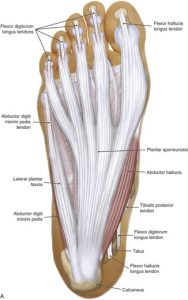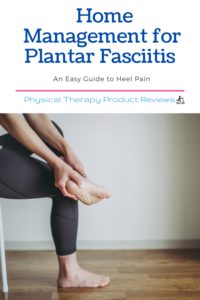Are you looking for a way to cure Plantar Fasciitis? You are not alone. There are more than 10,000 google searches each month on how to fix Plantar Fasciitis. Plantar Fasciitis can be difficult due to its constantly high levels of pain and pain that can remain for months if not taken care of properly. The pain often starts in the morning with the first few steps out of bed and can last until you get to lie down again, finally giving your feet a rest. Each step can feel like a sharp tack is poking into the heel limiting your work, home duties, and play.
Treating plantar fasciitis can also be expensive with potential multiple visits to the doctor’s office with no guarantee that the treatments will work. By the time that you see a rehab specialist, it often has been months of agony and pain, and the bottom of the heel is flared up all day. The longer the time since the onset of symptoms, the longer it takes to return to normal. Wouldn’t it be nice if you could treat your heel and foot pain at home?
What is Plantar Fasciitis?
 The plantar fascia is a thickened band of tissue underneath the foot that supports the arch of the foot in weight-bearing positions. It starts on the inside of the bottom of the heel bone and attaches in five separate bands at the base of each toe. The plantar fascia is put under stress with weight-bearing, especially during late phases of the gait cycle as we begin to push off with our big toe. The tension of the plantar fascia helps passively locks the midfoot for stability during walking and aides in our ability to move forward.
The plantar fascia is a thickened band of tissue underneath the foot that supports the arch of the foot in weight-bearing positions. It starts on the inside of the bottom of the heel bone and attaches in five separate bands at the base of each toe. The plantar fascia is put under stress with weight-bearing, especially during late phases of the gait cycle as we begin to push off with our big toe. The tension of the plantar fascia helps passively locks the midfoot for stability during walking and aides in our ability to move forward.
It’s estimated in the literature that around 7% of people over the age of 65 report pain on the bottom of the heel and results in over 1 million doctor visits per year (1). While most cases of plantar fasciitis respond to conservative treatment and time, around 1% of patients will require surgery.
What Causes Plantar Fasciitis
 Even though plantar fasciitis is a relatively common problem, the actual tissue changes are not fully understood. It is theorized to be an inflammatory condition caused by repetitive microtrauma and tensioning at the heel. However, evidence of inflammation was not found in histological samples during surgery. Adding more cloudiness to the picture is that plantar fasciitis often responds favorably to steroid injections, which typically combats the inflammatory process. Therefore, inflammation is part of the puzzle but not the whole puzzle.
Even though plantar fasciitis is a relatively common problem, the actual tissue changes are not fully understood. It is theorized to be an inflammatory condition caused by repetitive microtrauma and tensioning at the heel. However, evidence of inflammation was not found in histological samples during surgery. Adding more cloudiness to the picture is that plantar fasciitis often responds favorably to steroid injections, which typically combats the inflammatory process. Therefore, inflammation is part of the puzzle but not the whole puzzle.
The repetitive microtrauma results in microscopic tears at the insertion of the fascia into the heel bone. The micro-tears irritates nerves, muscles, and may cause more inflammation (see above on inflammation.)
It is most commonly caused by a sudden change in activity and often exacerbated by poor footwear selection during tasks, decreased foot, ankle, and hip strength, prior injuries to the big toe or foot, and tightness in the calf muscles. The change in activity may not be planned and it often occurs in those that have careers requiring more time on their feet such as nurses, servers in restaurants, police officers, etc.
How to Treat Plantar Fasciitis at Home?
Wouldn’t it be nice to begin treatment on yourself on the path to pain-free walking? Treating Plantar Fasciitis at home can for the most part be broken down into two steps: Calming down the tissue, and loading the tissue. In the vast majority of patients with plantar fasciitis, they are sent home with only stretching exercises for their calf and foot. This is only half the battle and a large part of why this seems to be so difficult to heel. It is not uncommon for someone to hear a sufferer say it returned 6-9 months later. To get rid of plantar fasciitis for good you, not only need to stretch but just importantly you need to regain the strength.
Decreasing Pain in Plantar Fasciitis and Calming Down the Heel Pain
Often times this is the hardest step of the whole process. How do you give your footrest and still live a normal life? Simply changing the pain pattern and offloading the heel is the first step.
Reduce Heel Pain with Ice/Heat/Creams
These are options to purely try and calm down the tissue. None of the creams or topical analgesics in the world will help cure plantar fasciitis but for now, let’s just calm down those nerves
Allows for pain relief throughout the day. All three act on pain through different pathways. Choose the way that feels best for you and go for it. When icing, rub the ice cup over the areas that hurt the most for 3-5 minutes.
- If heating, use a moist heat pack on the area of pain for 15-20 minutes.
- When using the creams, rub into the skin directly on the bottom of the heal. Careful not to do too much because the sensation intensifies when you put on socks.
Foot Support for Plantar Fasciitis
Plantar Fascia Inserts

Supportive Shoe such as Asics

Plantar Fascia Compression

Night Splint for Plantar Fasciitis
Plantar Fascia Night Splint

Self Foot Massage for Plantar Fasciitis
This is not to break up scar tissue or adhesions as there is currently no research to support the breakup of adhesions without surgery. How these rollers and spikey balls likely work is by changing the stimulus to the nervous system and scrambles to pain signals to the brain. This results in lower perceived pain levels. It may also help with increasing blood flow to the area which can aid in healing.
Foot Rollers and Balls
Self Foot Massage for Plantar Fasciitis
Often performed simultaneously or shortly after the pain relief/calming down the tissue phase. The goal of this phase is to have to the body adapt to tension on the fascia and building tolerance.
Plantar fascia stretching – A randomized controlled trial investigated specific Achilles tendon as compared to plantar fascia stretching exercises in patients with chronic plantar fasciitis. The short-term outcome demonstrated superior results in the plantar fascia stretching group compared with the Achilles stretching group so make sure to do both (2)
- Plantar fascia stretch:
- Achilles/calf stretch:
- Soleus stretch:
Once the heel and foot have calmed down it’s time to load or strengthen the foot so that the pain doesn’t come back. It’s important to note that some discomfort may be expected with some of the below exercises, but you should back off if there is pain greater than 3-4/10.
Strengthening the Foot and Ankle for Plantar Fasciitis
Once the plantar fascia and the heel are calmed down and you can walk on it for short distances. We want to strengthen the area and promote adaptation.
The first set of exercises it used to gain motor control of our foot, meaning that we need to have the strength within the muscles of the foot to support the arch when we are in standing. These need to be performed daily and are important to master before moving on to the advanced loading exercises.
- Foot Intrinsic Exercises
- Theraband Foot Intrinsics
- Towel Scrunches
Advanced Plantar Fascia Strengthening Exercises
The goal of this set of exercises is to really load the tissue and maximize tissue adaptation. We want this to be difficult yet not painful. We want to induce tissue change and strengthen the arch of the foot to bear load normally and help you return to the activities that you love to do.
- Eccentric double leg calf raises
- Eccentric single-leg exercises in toe extension
- Toe extension lunges
- Plyometrics
Works Cited
- Dunn JE, Link CL, Felson DTet al Prevalence of foot and ankle conditions in a multiethnic community sample of older adults. Am J Epidemiol 2004; 159: 491–498- https://www.ncbi.nlm.nih.gov/pubmed/14977645
- Lemont H, Ammirati KM, Usen N. Plantar fasciitis: a degenerative process (fasciosis) without inflammation. J Am Podiatr Med Assoc 2003; 93: 234–237 – https://www.ncbi.nlm.nih.gov/pubmed/12756315
- DiGiovanni BF, Nawoczenski DA, Lintal MEet al Tissue-specific plantar fascia-stretching exercise enhances outcomes in patients with chronic heel pain. A prospective, randomized study. J Bone Joint Surg Am 2003; 85: 1,270–1,277 – https://insights.ovid.com/pubmed?pmid=12851352
Other Great Rehab Related Articles
Dealing with Painful Stairs After Ankle Replacement Surgery
Walking After a Total Ankle Replacement: Tips for a Successful Recovery
Exercises While Non-Weight Bearing After Ankle Replacement: Elevation, AROM, Leg Raises, and More
Ankle Pain with Stairs: Causes and Home Treatment Options
5 Common Mistakes You’re Making After an Ankle Sprain
6 Great Ways to Reduce Low Back Pain with Driving
Disclaimer: The information provided in this post is for educational purposes only. This is not a substitute for a medical appointment. Please refer to your physician before starting any exercise program.








